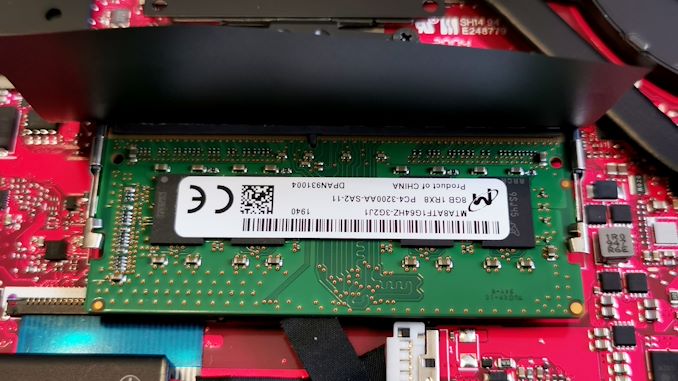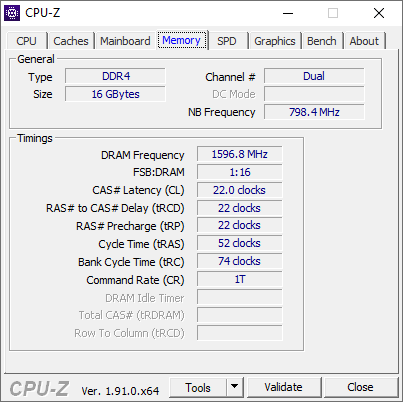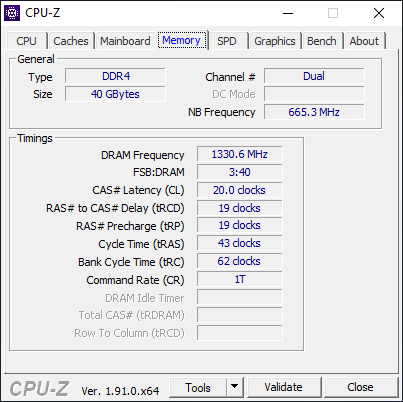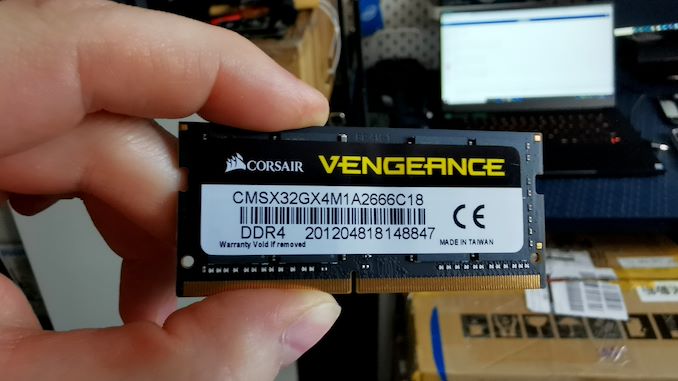AMD’s Mobile Revival: Redefining the Notebook Business with the Ryzen 9 4900HS (A Review)
by Dr. Ian Cutress on April 9, 2020 9:00 AM ESTRyzen 9 4900HS with DDR4-2666 and DDR4-3000
In our ASUS Zephyrus G14, we have a total of 16 GB of DDR4. This is split between a single SO-DIMM module of 8 GB, and a set of 8 GB memory soldered onto the board. AMD will offer a version with 16 / 16, however this might come at a later date.
This memory is running at the AMD recommended for these processors, DDR4-3200. Through our inspection tools, we can tell that this memory is running with subtimings of 22-22-22 with a command rate of 1T. The command rate is certainly good, however the 22-22-22 is a little slower than what we see on a desktop system running at this speed, because here we have a system that conforms to JEDEC’s subtiming requirements.
For our memory testing we wanted to see what speeds and capacities we could achieve. Corsair very kindly sent us some modules of 16 GB DDR4-3000 and a module of 32 GB DDR4-2666. This would give our system either 24 GB or 40 GB total respectively, which for a machine designed to do heavier duty workloads, having >16 GB is certainly welcome, as long as the performance hit isn’t too much.
I installed the 32 GB module, and the system booted first time with no fuss. A quick look to see if all the capacity was seen, and we had a total of 40 GB. The speed was also as expected, at DDR4-2666 but with subtimings of 20-19-19 1T.
However, when we put in the module of 16 GB DDR4-3000, to get a total of 24 GB, the detected speed inside the system was only DDR4-2666. Looking at the module settings, this was because the DDR4-3000 speed was actually an XMP profile, and ASUS has not enabled the ability to set XMP profiles here.
We were able to get DDR4-2666 on the 32 GB module because this is the base frequency and settings for the module. The same with the 8 GB module that came with the system – it was flashed so that the basic SPD setting was DDR4-3200. If users want to get high capacity modules with the faster DRAM speeds on this system, they will have to configure the primary SPD profile of their modules, which isn’t an easy thing to do.
As a result, our tests are going to come down to the 8 GB DDR4-3200 module that came with the system, and compare it to the 32 GB DDR4-2666 module. Note that the latter is an 8+32 configuration, which is expected to run in dual channel for the first 16 GB, and then single channel for the next 24 GB.



With our AI test, there’s a ~20% benefit from having the faster memory, which decreases slightly when moved to a limited power budget.

We didn’t see any difference in something like Cinebench.

There was more of a difference in PCMark 10, however PCM10 isn't that great in showing where the bottlenecks are.
Integrated Graphics Tests


For the Civ 6 graphics test, the difference in performance between the two memory settings is really significant. This sort of game cares less about FPS, however going down to 22 FPS for 1080p Max and No MSAA means that the user probably has to dial that back a bit to get something more reasonable.


Going from plugged in to not plugged in, we didn’t see much of a change with the slower memory, however the DDR4-3200 setting still gets a serious benefit over the DDR4-2666 arrangement.

For Final Fantasy, there a significant change - moving up from DDR4-2666 to DDR4-3200 affords a +30% improvement.
Discrete Graphics Tests




In each case, the faster DRAM actually improves discrete graphics performance.
Quick Thoughts
Overall, 16 GB of memory in a system like this isn't the best configuration - people who need the power are going to likely want 32 GB. However, users putting in their own fast module when buying the 16 GB version are going to have to be careful about the performance. Both the integrated graphics and the discrete graphics take a knock on performance going down from DDR4-3200 to DDR4-2666.















267 Comments
View All Comments
guachi - Thursday, April 9, 2020 - link
I was looking at the very Razer you had in this review. Ended up preordering the Asus.So I thank you for the review and the comparison choice.
Mat3 - Thursday, April 9, 2020 - link
I know that's not a real die shot, but even so, that's the worst "fake" die shot I've ever seen.StevoLincolnite - Thursday, April 9, 2020 - link
I have a Ryzen 2700u notebook which I will happily toss out the window for this.ballsystemlord - Thursday, April 9, 2020 - link
Spelling and grammar errors:"If Intel has a lower frequency, fewer cores, and a lower frequency, all for the same power envelope as AMD, then it looks like a slam dunk for AMD."
Double "lower frequency":
"If Intel has a fewer cores and a lower frequency, all for the same power envelope as AMD, then it looks like a slam dunk for AMD."
"When the system does the battery life done right, it's crazy good."
Badly worded:
"When the system balances performance and battery life, it's crazy good."
mkozakewich - Thursday, April 9, 2020 - link
On these kinds of systems, battery life can tank when something goes wrong. I wonder if there was also a reason that the Intel system was showing such poor battery life.When AnandTech reviewed the Surface Book, I remember them giving it a really low battery life score. It turns out there's some kind of problem with the GPU connection, and the device will get twice the life if you disconnect and reconnect the tablet portion multiple times. I actually get 12 hours on my 2017 Surface Book 2. The system can run on 4 W. So, finally! I've never even considered an AMD system, because they would run closer to 8 or 12 watts, and that meant they'd either have a massive and heavy battery, or they'd only last a few hours.
But the caveat: As you see here, and with the Surface Book, that efficiency can go out the window if one thing goes wrong.
zodiacfml - Thursday, April 9, 2020 - link
Thanks for the Anandtech quality review. I hope we see cheaper 8 core laptops without discrete graphics. Seeing the performance of the iGPU on two memory speeds, hope to see AMD with integrated memory in its future products like what they did in the PS5/Series X, great for mobile and compact desktop PCsplonk420 - Friday, April 10, 2020 - link
thanks for the latency numbers! huuuuge help for emulation fans (or at least PS3 emulation fans)!deil - Friday, April 10, 2020 - link
a bit high idle speed, but that response times is what we want most for "snappy laptop" which feels fast. I really want one now...Haawser - Friday, April 10, 2020 - link
Hey Ian, could you do some iGPU game tests with a 720p render target, but running full screen with RIS ? I'd be interested to see if you can get much higher frame rates but without a massive loss of subjective IQ ? Cheers.Fulljack - Friday, April 10, 2020 - link
I'm interested with AMD 25x20 initiative. Could you please make an update for it? Last time you did was two years ago back in 2018. It would be an interesting piece of article to show how much AMD has grown. Thanks!https://www.anandtech.com/show/13326/amd-updates-i...